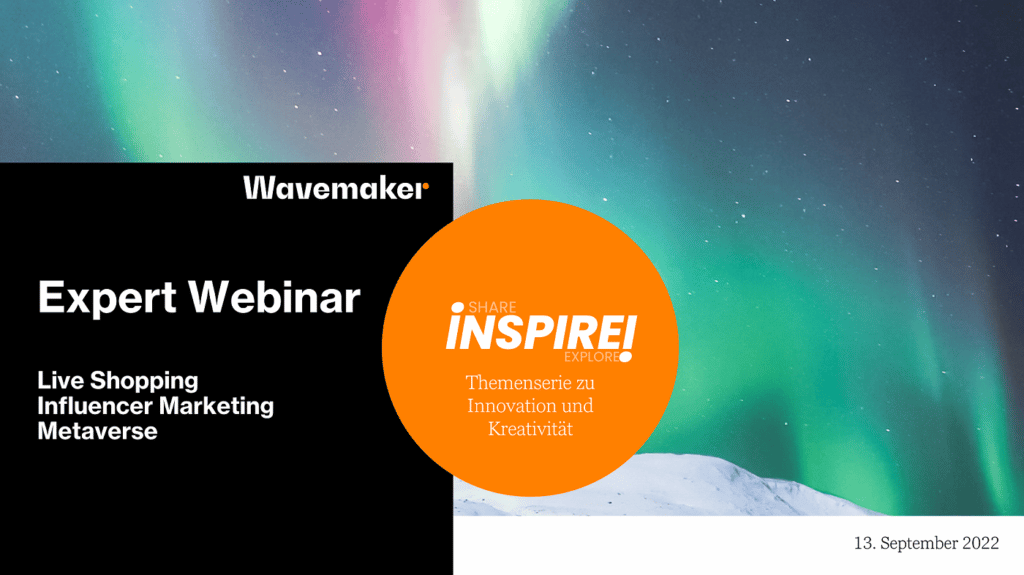The Provocateur – Sonderserie „OUTSIDE THE BOX“: Wavemaker Experten analysieren zum Nachdenken anregende Themen und teilen mit uns offen ihre Meinung und Gedanken.
Welcome to the third episode of Outside the Box. Today we’re talking addressable media in TV and online video. Two leading experts in very different markets – the US and Australia – talk about how their clients are using addressable. And there are some surprises! Although on paper Australia is an emerging market in this area, it is fast catching up with more mature markets, applying addressable techniques far beyond standard audience targeting. Where both converge is a clear challenge to brands (and their agencies) to think bigger and go faster in a field bursting with opportunity for the bold.

Vinny Rinaldi, US Head of Investment

‘When people talk about addressable media, what they mostly have in mind is personalised 1-1 marketing, using consumer data to super-target multiple audiences of any size – the evolution of programmatic media.
This definition isn’t wrong – but it’s also a long way from right. Addressable media is not just about the audience. It’s also not a channel, or a type of media, and it’s time we stopped thinking about it that way. Until we do, we are missing the huge potential for business growth that addressable offers.
We should stop looking at addressability as a channel and start looking at it as a means of doing business. Its lifeforce is technology – the clue is in the name – addressable media is the ability to address any data point as an impression. Taken to its logical conclusion, this means every impression we buy based on a data point is targetable. This includes audience data points, but it also includes a wide spectrum of business data points.
Let me give you an example from my previous job, client-side as Head of Addressable Media and Technology at Hershey’s. Halloween is Hershey’s Superbowl. It’s the biggest day of the US chocolate giant’s year. The only problem is that if your network of retailers don’t sell their stock before 1 November, that stock is marked down and sold at a hefty discount.
We knew that we had to get our product off the shelf before 1 November, and to do that we needed to sell through as much as possible. So, in the pre-Halloween period, we used addressable media to focus on the markets that were underselling against the national average of 84%. This was our addressable data point and we turned on media in any market underperforming against it. We only spent money in markets performing below the national average. By doing this, at the end of the campaign we were able to attribute $5M in incremental sales on a $1M media spend.
 The future is exciting, and despite 90% of what you read, getting less complicated as technology takes the strain. When I started at Hershey’s, my job was all about programmatic media; by the time I left it was about addressable media in every non-linear channel – search, social and video. All of these channels have a biddable component, which creates a marketplace in which there is the ability to buy impressions with data points – that means that every biddable platform is addressable. Maybe in theory now, in some cases, but in practice pretty soon. The simplest way to think of it is this: You can bring data into every platform behind an impression.
The future is exciting, and despite 90% of what you read, getting less complicated as technology takes the strain. When I started at Hershey’s, my job was all about programmatic media; by the time I left it was about addressable media in every non-linear channel – search, social and video. All of these channels have a biddable component, which creates a marketplace in which there is the ability to buy impressions with data points – that means that every biddable platform is addressable. Maybe in theory now, in some cases, but in practice pretty soon. The simplest way to think of it is this: You can bring data into every platform behind an impression.
I’ve been agency-side at Wavemaker US for two months – and this is my mission: To bag exceptional growth for our clients by positively provoking them to use addressable media for much, much more than audience-targeting.
Let’s finish with one more example. Say I’m a manufacturer (of cars, jeans, lipstick, it doesn’t matter) with an exciting new product to launch. I decided to launch it in 30 markets. But I only buy media in 15 of these markets. Addressability allows me to run a classic control-and-test experiment with laser-like precision – to test any marketing hypothesis of my choosing.
This is its beauty – this is where addressable media closes the gap between data science, investment and activation.
Upwards of 90% of my clients at Wavemaker use addressable media. Each is at a different point on the spectrum of addressable maturity. This is what excites me – the untapped potential that we are exploring as we move along that spectrum in the right direction.’

Philippa Noilea-Tani, ANZ National Head of Investment
‘2021 has been a game-changing year for TV in Australia. TV audiences are at an all-time low but demand is at an all-time high, driving significant inflation in the market and leaving clients asking ‘where to now?’
 ROI for TV remains unrivalled, but for many brands it is too expensive to sustain a profitable presence. The rising cost of linear TV and the erosion in reach means that the threshold at which brand activity is driving a sales or other business outcome is out of reach for many – and in these cases we discourage clients from advertising on TV.
ROI for TV remains unrivalled, but for many brands it is too expensive to sustain a profitable presence. The rising cost of linear TV and the erosion in reach means that the threshold at which brand activity is driving a sales or other business outcome is out of reach for many – and in these cases we discourage clients from advertising on TV.
Addressable TV offers a place to turn; its efficient targeting makes it cheaper without compromising screen size or coverage. There are challenges – we’re still working on improving the consumer experience of addressable ads – but previous barriers like frequency control are fast being overcome.
Finecast, our addressable TV solution from Wavemaker’s parent company GroupM, has been pivotal in these improvements. In August last year we launched Finecast ID in partnership with broadcasters, enabling advertisers to cap frequency and maximise reach across the Australian connected TV (CTV) ecosystem. This shift has fuelled growth, with more than 70% of Wavemaker clients evolving their video strategies to incorporate addressable TV, for audience targeting and much, much more.
The Auto category is just one great example. Finecast has proven to be super-effective at building brand awareness of new nameplate launches (+46% in awareness vs control group), driving positive brand opinion (+54% vs control group) and increasing purchase intent (+42% vs control group).
What’s really resonating with clients is the instant way we can utilise addressable to respond to key trigger moments. One example I love is in share-of-voice. Take any highly competitive category. Using real-time competitive insights, we can link up the moments a competitor changes a product, promotes a new feature, offers a new price point or targets a new geography – and respond within seconds, by region, daypart or creative, enabling us to combat rival SOV and command the highest attention and visibility.
Whether those trigger moments are linked to site traffic, store footfall, trending content, sales, competitor activity, or anything in between, addressable media is enabling real time optimisation at scale – and the benefits are stark.’








